The Scientific Method
The foundation of all science is a process called the scientific method. If you want to answer a question from a scientific perspective, you'll be using the scientific method. If an investigation doesn't use this method, it's not using science.
The scientific method is a fairly straightforward process that includes asking a question, suggesting an answer, then testing that answer. Although the overall process is always basically the same, the finer details and the way it's implemented vary depending on many factors. You'll see the method described and depicted in different ways, but it will always follow this general path:
Observation > Question > Hypothesis > Testing > Results > Conclusion > Theory
Notice that the theory is the last part of the process. In science, the word theory has a different meaning than the one we use in everyday life. This is important and we'll get back to it later.
The graphic below shows one way to visualize the scientific method.
The process begins with an observation of something in the world around us. For example, "The sky is blue".
This leads to one or more questions, such as "Why is the sky blue?"
The next major step is to propose a hypothesis, or suggested answer to the question. However, before we do this, we should:
- Make sure we're asking the right question.
- Do some background research, including finding out if the question has already been answered. If it has been answered, is the answer satisfactory? Could you propose a better answer?
Hypothesis
Once you've learned all you can about previous investigations into the question, you can come up with your own suggestion. In everyday conversation, this is what you might call a theory, e.g. "My theory is that water droplets in the atmosphere make the sky blue". In science, you don't call your idea a theory, you call it a hypothesis. Hopefully the theory will come later (see below).
Now we need to learn some rules. A valid hypothesis must meet certain criteria, or it won't be able to continue through the process. In a very loose order of priority, here are some important rules and recommendations:
- The hypothesis must answer the question, or else it serves no purpose.
- The hypothesis must match observations that we see in the real world.
- The hypothesis must be testable, since that's the whole point of science. If the hypothesis turns out to be false, is there any test that would show that it's false? If not, you can never be sure that it's true.
- The hypothesis should predict future observations.
- The more specific and detailed the hypothesis, the better.
- The more parsimonious and conservative, the better. The "principle of parsimony" (AKA "Occam's razor") means relying on the least number of unsupported assumptions. A hypothesis that states "The sky is blue due to unknown particles in the air" makes an assumption that is not yet supported by evidence, so it is not parsimonious.
- Being "fruitful" and having a "wide scope" basically means that the hypothesis will have benefits beyond answering this one question. These qualities are not required, but they are certainly nice to have.
Testing
Scientific tests are based on experimentation. Wherever possible, experiments will be conducted in strictly controlled conditions. An experiment should account for variables and any factors that may affect the result. Everything should be thoroughly documented.
There are many, many rules about testing. Students of science spend years learning how to design and implement experiments fairly, accurately and transparently.
Results
Results of the testing should be as clear as possible, with little room for doubt or conflicting interpretations. Anyone should be able to repeat the same tests and get the same results.
Conclusion
Results should lead to a clear conclusion, which should then be presented to other scientists for peer review. It is likely that this part of the process will raise further questions and challenges which must be addressed.
If the conclusion passes peer review, it is communicated to a wider scientific audience for more scrutiny and comparison to competing hypotheses and theories.
Theory
If the hypothesis makes it this far, it may become accepted as a theory. As mentioned previously, this is essentially the last part of the process. A scientific theory is the ultimate goal—it means that the hypothesis has been recognized by the scientific community as a valid explanation for something in the natural world.
So, don't ever say that something is "just a theory". In a scientific context, calling something a theory is high praise.
In the best-case scenario, this new theory will go on to provide explanations for many other things, not just the observations that prompted this investigation.
Page information
Author: Dave Owen

